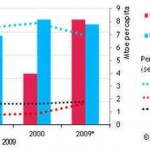Erlanger, Kentucky – The U.S. Environmental Protection Agency (EPA) has awarded Toyota Motor Engineering & Manufacturing North America, Inc. (TEMA), with a 2010 ENERGY STAR Sustained Excellence Award in recognition of its continued leadership in protecting the environment through energy efficiency and management. TEMA’s accomplishments were recognized at an awards ceremony in Washington, D.C. on March 18, 2010.
Separately, the Toyota Technical Center’s (TTC) York Township, Mich., campus has been recognized by the U.S. Green Building Council (USGBC) with a Gold Leadership in Energy and Environmental Design (LEED) Certification for its commitment to environmental stewardship.
Energy Star Sustained Excellence Award
TEMA, an ENERGY STAR partner since 2003, was honored with its sixth ENERGY STAR Sustained Excellence Award for its long-term commitment to the environment across its ten manufacturing operations in the U.S. Across the nation, top companies and organizations are leading the way toward a more energy-efficient future through participation in ENERGY STAR.
“Toyota’s commitment to sustainability reaches beyond just manufacturing vehicles,” said Kevin Butt, Chief Environmental Officer of TEMA. “Our research and development efforts focus on developing the cars and manufacturing technologies for the future. And our best resource to achieve this vision is our team members, who have paved the way to a sustainable future.”
Examples of energy improvements at TEMA’s manufacturing facilities include:
- Reducing total energy use by 19 percent per vehicle produced since FY2000 while expanding and adding new facilities;
- Reducing water usage by 20 percent per vehicle produced since FY1999 through no- and low-cost improvements;
- The installation of solar panels at the Huntsville, Alabama engine plant – the first Toyota plant in the U.S. to have one. The new five kilowatt solar panel generates enough energy to light four bays of floor space, or over 16,000 square feet; the equivalent of 80 60-watt light bulbs;
- At the Georgetown, Kentucky plant, the plastics shop reduced their shut down energy use by 83 percent from the previous year.
Energy improvements at Toyota manufacturing facilities have saved more than $30 million annually and reduced CO2 emission by almost 150,000 metric tons, equal to 19,000 homes.
Since 2006, Toyota’s U.S. manufacturing operations have received 14 Energy Star Plant Awards from the U.S. EPA, recognizing each plant’s energy performance over the past year and scoring in the top 25 percent of its industry.
The 2010 Sustained Excellence Awards are given to a select group of organizations that have exhibited outstanding leadership year after year. These winners have reduced greenhouse gas emissions by setting and achieving aggressive goals, employing innovative approaches, and showing others what can be achieved through energy efficiency. These awards recognize ongoing leadership across the ENERGY STAR program including energy-efficient products, services, new homes and buildings in the commercial, industrial and public sectors. Award winners are selected from more than 12,000 organizations that participate in the ENERGY STAR program.
Gold LEED Certification
When it opened in October 2008, TTC’s York Township campus represented a $187 million investment in the state of Michigan and was constructed with the environment in mind.
“From the planning and design stage, our top priority was to maximize the building’s energy efficiency,” said Robin Haugen, General Manager of Production Engineering at TEMA. “Reducing energy use and improving efficiency is major priority for Toyota across North America.”
LEED points are awarded on a 69-point scale and credits are weighted to reflect their potential environmental impacts. The York Township building scored 40 points, earning Gold recognition.
Examples of environmental & energy efficiency efforts at TTC’s York Township campus include:
- Brownfield redevelopment site (use of an existing property which was idled or underused due to environmental hazards);
- Installation and use of an under-floor HVAC supply system, reducing energy use by nearly ten percent;
- Use of construction waste and installation of low volatile organic compounds, such as paints and carpeting;
- Nearly 40 percent of the installed recycled materials in the building were from within a 500 mile radius;
- Reduced water use through planting low maintenance landscape and reduced/waterless fixtures.
LEED Certification is an environmental distinction among commercial office buildings in the country that are committed to energy savings, water efficiency, CO2 emissions reductions, improved indoor environmental quality and stewardship of resources and sensitivity to their impacts.
Developed by the USGBC, LEED provides building owners and operators a concise framework for identifying and implementing practical and measurable green building design, construction, operations and maintenance solutions.
Source: Toyota.








